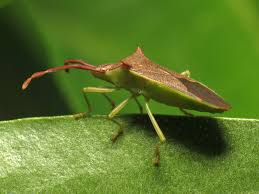 With year of experience in the field growing trees, Heritage Oak Farm has experienced its share of pests, viruses, and fungus. When we find information that we think might be helpful to you, our tree farms and nursery owners, we bring it to you. This little pests is a huge problem for many orchards and tree farms. Knowledge is power. Fight the bug!!
With year of experience in the field growing trees, Heritage Oak Farm has experienced its share of pests, viruses, and fungus. When we find information that we think might be helpful to you, our tree farms and nursery owners, we bring it to you. This little pests is a huge problem for many orchards and tree farms. Knowledge is power. Fight the bug!!
Leaf-footed bugs are medium- to large-sized insects that are related to stink bugs. They get their name from the leaf-like enlargements on their hind legs. Leaf-footed bugs feed on fruits, fruiting vegetables, nuts, and even ornamental plants. They prefer to feed on seeds, but will use their needle-like mouth parts to suck juice from almost every part of a plant. Most of the time growers don’t have to worry about large outbreaks, but in the cases where infestations happen, large portions of a crop can be lost. Here is what your customers need to know to deal with these pests.
What to Look For
Adult leaf-footed bugs attack fruits just as they ripening, causing them to drop. This can be very frustrating for customers who work all summer tending their garden or ornamentals. Teach your customers how to identify leaf-footed bug damage early so that they can save their crops.
In general, leaf-footed bug damage can be identified by small spots of rot where the insect punctures the fruit. Most leaf-footed bugs carry yeast in their mouthparts. This fungus causes discoloration of fruits in spots and stripes. It can be easier to identify, in early stages, than rot. Note that the yeast itself does not cause damage that would prevent fruit from being harvested.
Prevention Is the First Step
Once the damage from leaf-footed bugs has been identified, it is time to do something about them. For the most part, leaf-footed bug populations remain low enough that the damage they cause can be ignored. Your customers may want to wait out the problem and address it after harvest. You can assure them that this is an acceptable strategy and that they will be able to address the bugs at a later date so that they don’t return next year.
The best way to prevent leaf-footed bug infestations is to remove weedy areas that serve as food for the bugs in winter and early spring. While removing weeds, gardeners should also look to remove overwintering sites as well. Wood piles, loose bark, and outbuildings are common places for leaf-footed bugs to spend a winter. Thistles are a favorite of leaf-footed bugs.
Addressing the Problem
When outbreaks of leaf-footed bugs occur, the problem usually can’t be addressed with a single measure. Pesticides, in particular, are usually not an option because leaf-footed bugs tend to attack just before harvest. Insecticides are also most effective against nymphs and it is the adults that do the vast majority of damage.
Before recommending insecticides, inform customers of options for physical removal and natural predators. Physical removal requires diligence and a pair of good gloves. The gloves are to protect against the odor leaf-footed bugs emit when handled. To remove smaller infestations, customers can brush the bugs off into soapy water (consider selling kits). For larger infestations, a vacuum dedicated to the bugs (remember the smell) is usually a good way to go. Small cordless vacuums work best. You can find robust options to sell that work well in outdoor settings. Remind customers to look under leaves for egg masses as they should be destroyed as well.
If physical removal is too time-intensive, then natural predators may help. Certain wasps, tachinid flies, birds, spiders, and assassin bugs are all natural enemies of leaf-footed bugs. Natural predators can reduce an infestation, but they cannot eliminate it. They often work best in conjunction with physical removal.
If clients choose to use insecticides as a last resort, pyrethroid-based options are the safest for humans. Unfortunately, they are highly toxic to bees, so they must be used with care. Because leaf-footed bugs are not particularly selective about what they eat, they can hide in cover crops, non-ornamental plants, and other plants that are not of direct interest to your customers. This generally means spraying an entire area, not just a crop of interest.
Your Role in Controlling Leaf-Footed Bugs
Landscape businesses and nurseries should serve three primary purposes when it comes to leaf-footed bugs. First, they should provide education and advice on handling these relatively uncommon pests. Second, businesses should supply the materials (e.g. gloves, outdoor vacuums, traps, etc.) needed to deal with the insects. Finally, businesses should provide updates on pest infestations. Gather information about pests by reading, visiting university extensions, and by talking to customers.
Resources
http://ipm.ucanr.edu
http://entnemdept.ufl.edu
http://ipm.ncsu.edu
